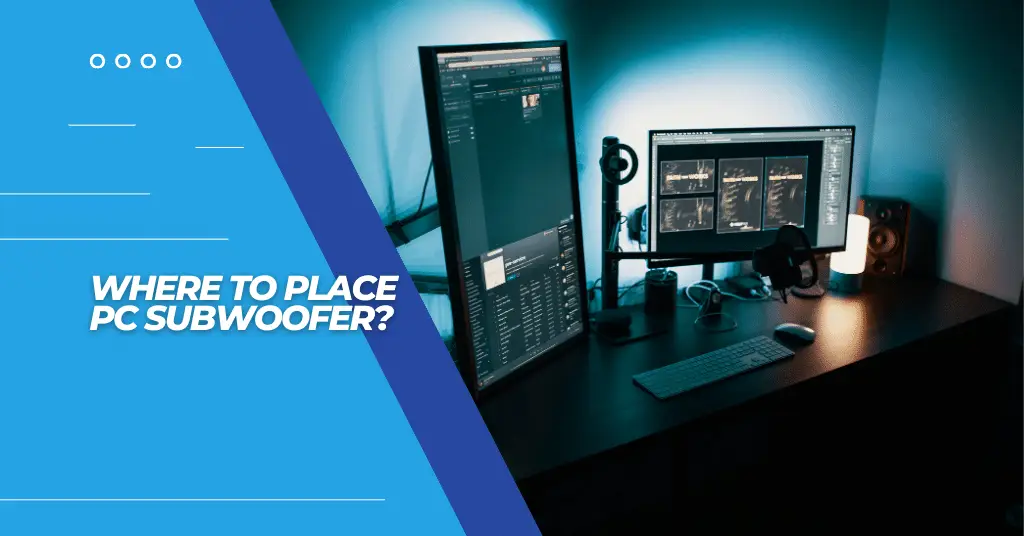PC Subwoofer Placement

Adding a subwoofer to your computer setup is a pretty good step. However, it might give you a tough time when placing the subwoofer on your desktop. That’s why many people ask me about where to put the subwoofer pc!
I would just say you can put the subwoofer on the desk next to your tower and under the desk between speakers or slightly off-center. However, both these placements have conditions that I will discuss further. But please avoid corners to prevent a “boomy” sound for best results if you don’t know how to calibrate the audio system.
Does Subwoofer Placement Really Matter for Your Computer Setup?
Obviously, that’s why you are here! Subwoofer placement significantly affects the audio quality of your computer setup. If you follow the correct positioning, you will get an optimal bass sound and minimize sound distortions while doing computer work. Conversely, incorrect placement may cause issues such as “boomy” sound, dead spots, overly resonant areas in the room, or even damage to your computer LCD or tower.
What Are the Ideal Subwoofer Placements for Your PC?
I will do my best to explain the correct answer about the PC subwoofer position (the rest of the decision is up to you). According to my experience, I have tried different placements with my computer setup, and this is what I have found:
1. Subwoofer Placement Desk:
Placing the subwoofer on a computer desk is pretty famous among audiophiles. But this positioning is not ideal for all subwoofers. This sub placement only works great with small subwoofers. Here are the pros and cons:
Pros
Cons
Tips for Optimizing Sound for Desk Placement:
If you are pretty serious about using desk placement for your subwoofer, you can follow the following tips to optimize your sound system:
Avoid Facing the Subwoofer Towards the PC:
Never face your subwoofer directly toward a PC or desk; it can degrade sound quality and potentially disturb hardware.
Why? The directed bass sounds can lead to vibrations, creating unwanted noise from rattling desk items and potentially affecting sensitive PC components’ performance and lifespan.
Moreover, if your subwoofer model obstructs any vents, it may impede airflow and cooling, which are critical for optimal PC operation.
Therefore, I suggest positioning the subwoofer away from direct alignment with the PC for enhanced sound clarity and hardware longevity.
Positioning:
The central location for your subwoofer between your speakers allows the low-frequency sound waves to distribute evenly across the room.
This creates a more immersive sound, offering better depth and dimension to the audio. A centrally positioned subwoofer can also minimize potential distortions or overshadowing of sounds from other speakers, giving you a clearer, more balanced audio output.
2. Subwoofer Under Desk:
Some users really love to place their subwoofer under the PC desk. Well, I am one of them. However, there are no major limitations to using the specific subwoofer size if you want to place it under your desk. Here are some pros and cons:
Pros
Cons
Tips for Optimizing Under Desk Placement:
Here are some tips that will enhance your PC audio system if you want to place the subwoofer under the desk:
Positioning:
If the subwoofer’s driver directly faces the desk’s surface, it could result in sound blockage, leading to reduced audio clarity and bass response.
A practical approach is to angle the subwoofer slightly rather than having its driver directly facing the desk or placing it at some distance from the desk legs.
This arrangement allows the frequency response to spread out more evenly, reducing the chances of sound waves being blocked by the desk and, as a result, enhancing your overall audio experience.
Isolation Pads:
Actually, you should always use a subwoofer while using an isolation pad between the subwoofer and the surface. Vibrations from the subwoofer can cause many issues, such as desk shaking and noise interference, affecting sound clarity and damaging other equipment.
The pads absorb these vibrations, making the sound more accurate and precise. Moreover, they prevent the vibrations from reaching other equipment on the desk, thus offering an added layer of protection.
3. Beside the Desk (Other Floor Placements for PC Subwoofer):
You can also put your computer subwoofer beside the desk. It can either be on the left or right side of the computer table. When you use this placement option, it can significantly affect the bass dispersion in the room. Bass sound is omnidirectional, meaning that it spreads evenly in all directions.
Thus, when the subwoofer is equidistant from the listener and adjacent walls, it creates a consistent bass output that avoids overbearing or diminished sound.
This subwoofer location also reduces any potential interference with other electronics on the desk. Moreover, a side placement offers easy accessibility and makes adjustments simpler. It also fits subtly into room aesthetics, as it is less visually dominant than a frontal or rear placement.
General FAQs
Can I Use More Than One Subwoofer for My PC Setup?
Yes, you can use more than one subwoofer for your PC setup. It’s important to note that using multiple subwoofers can enhance the overall sound quality by evenly distributing bass frequencies across the room. However, the setup process might need careful adjustments to avoid phase cancellation issues and achieve a harmonious sound blend.
Should Computer Subwoofers Be on the Floor?
Placing the subwoofer on the floor or keeping it elevated is your personal choice. However, subwoofers are designed to produce low-frequency sounds that travel better through denser mediums like the floor. However, it is advisable to use a subwoofer pad or isolation platform to avoid vibrations and potential distortions.
How Far Should the Subwoofer Be From the Wall?
The placement of a subwoofer can significantly influence the sound quality of your audio setup. As a general rule, placing the subwoofer a minimum of 2 feet from the wall is recommended.
Can You Put a Subwoofer Too Close to a PC?
Technically, you can place a subwoofer wherever you want. However, putting it too close to a PC can potentially cause problems. Subwoofers create strong vibrations that can cause internal damage to the PC components over time. Furthermore, they emit electromagnetic fields that may interfere with the electronic systems inside the PC, leading to performance issues or data loss.
Can You Also Use the Crawl Technique to Find a Sweet Spot for a Computer Subwoofer?
Yes, the crawl technique can find the best spot for a computer subwoofer. Start by placing the subwoofer at your usual listening position, then crawl around the room while playing bass-heavy music. The ideal place, or ‘sweet spot,’ is where the bass sounds best to you.
